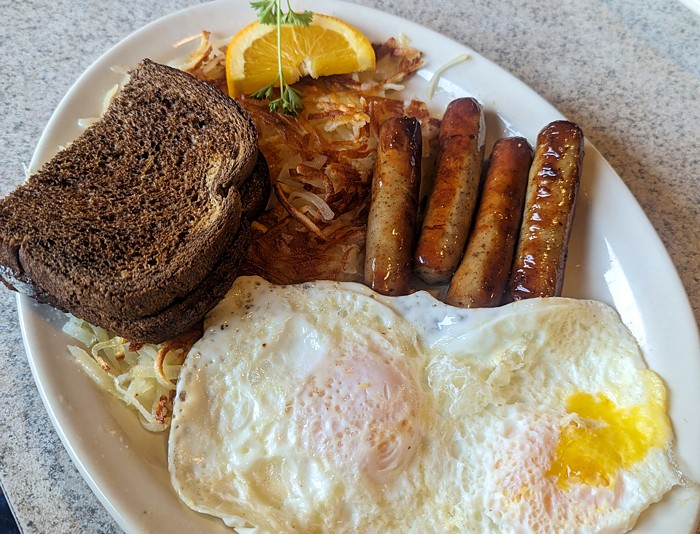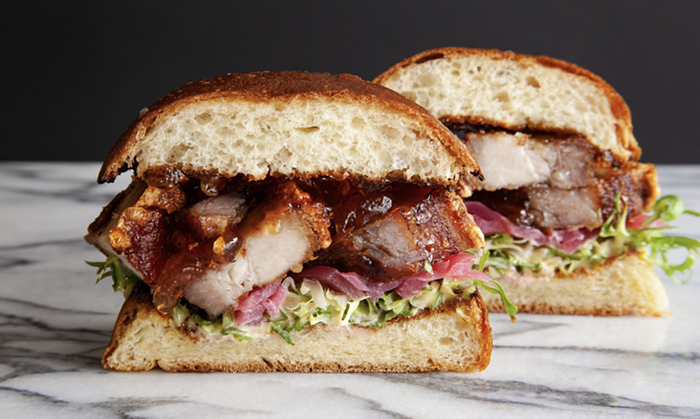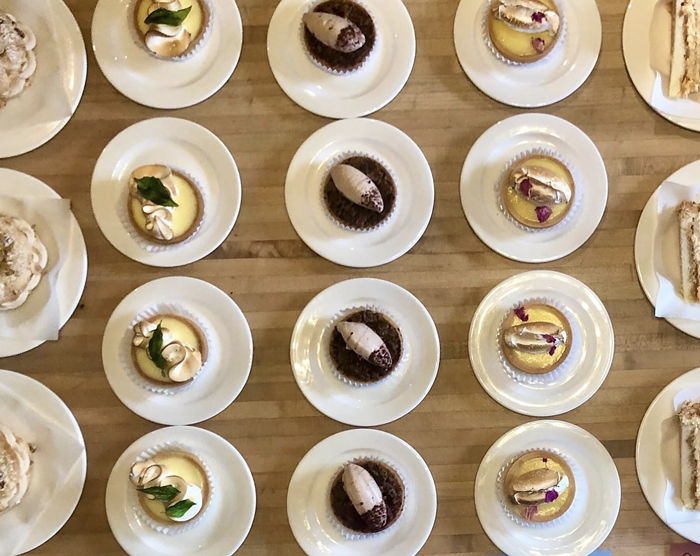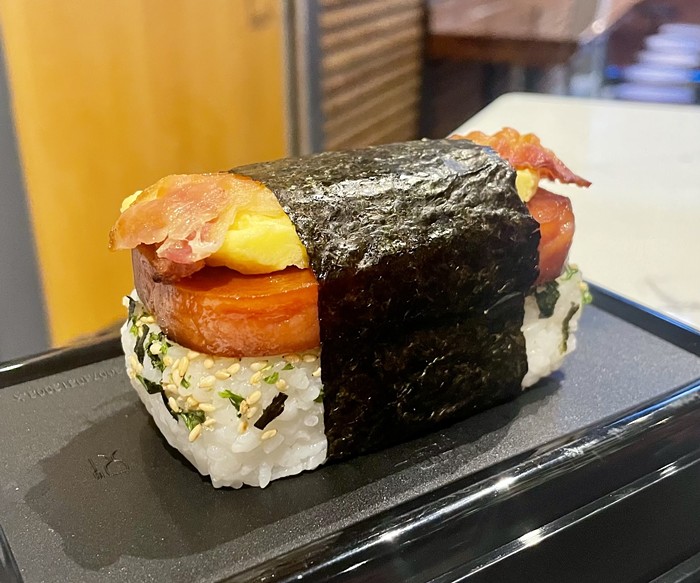Blueacre Seafood is in the immense space at the corner of Seventh and Olive where the Oceanaire Seafood Room used to be. Oceanaire, you may recall if you had money spilling outof your pockets in the aught-aughts, was part of a fancy seafood chain out of Minneapolis, and its interior resembled a luxurious old-fashioned ocean liner: wood polished to the finest shine, shipshape silver hither and yon, leather booths, black-tied servers. It never crossed the line into ostentation (and it all made the acoustical-tile ceiling with all its sprinklers easy to ignore; why would you look up?). The menu—freshly minted every day and longer than your bespoke-suited arm—offered a dumbfounding number of options, the most impressive of which was the Grand Shellfish Platter, a monolithic tower of oysters on the half shell, crab legs, lobster claws, prawns, and their assorted friends.
The Grand Shellfish Platter cost approximately $157 and was arguably worth it—at least when Kevin Davis was the chef. During his tenure, Oceanaire earned grudgingly great reviews from both critics and citizens—grudging because everyone wished it was a locally owned great downtown fish place, not some chain (from the Midwest!). Soon enough, Davis threw off the shackles of his corporate overlords, as a good man should, and opened his own place, Steelhead Diner in Pike Place Market. The well-liked Steelhead features upscale diner decor and possibly the best crab cake on the planet—basically a baseball of lump Dungeness crab meat with the merest inkling of a binding agent. I would like one of these crab cakes as part of my last meal, if I have any choice in the matter.
Seattle's branch of Oceanaire finally hit the iceberg of the new economy and sank in 2009. In a move that must be called balls-out, Kevin Davis (re)claimed the space as his own, opening Blueacre Seafood this financially frightening March—Blueacre, the place in the Oceanaire space that promised to be as good as Oceanaire in its Davis heyday, but locally owned, by Davis! There was to be justice in the world, and there was to be excellent seafood. There was rejoicing.
Davis promptly de-pomped the interior. It's got blues and greens now, and the snowy white tablecloths have been replaced by tabletops decorated with abstract butterflies to symbolize transformation—and to make you feel like you could get slightly messy with your dinner and not look like an inveterate slob. With the poshness subtracted, the place feels a little generic; you know without a doubt you're in the first floor of an office building now, in a certain kind of midrange upscale restaurant that is perfectly inoffensive, but not particularly impressive. The best places to sit remain the booths: the huge semicircular ones in one zone, the smaller but comfy ones in the midregion. (Avoid the booths, however, near the open window to the kitchen; here you get the clatter and the fluorescent light of the action, but you can't actually see any of it. For that matter, from across the room, all you witness is sometimes-stressed faces and plastic racks of glassware, not hands at work.)
The food, too, is de-pomped and less expensive: You can dine well at Blueacre for probably half what you'd have spent at Oceanaire. The wine list, long and Washington-focused, has a glass on it for six dollars (unthinkable in the Oceanaire era); there are sandwiches and burgers at dinnertime for just over $10 (ditto); some entrées come in two sizes (ranging from $19.95 to $28.95, with the small size not of the precious, tiny variety). The servers gently push extra sides you don't really need. (They're called "sideways"—the menu categories are precious, like "the sunbleached shell" for shellfish, "boil & bubble" for soups/stews, etc.). Avoid the fried green tomatoes, hard disks of breading, as if the poor slices of tomato have grown a sandy cornmeal carapace.
Blueacre's fish is fantastic: superbly fresh, perfectly cooked. Excepting one unfortunate plate of scallops that someone had grilled to tough on the outside, gummy and raw on the inside, the main ingredients of "the briny sea" category were without flaw. A roasted Alaskan black cod that had been rubbed with chardonnay lees fell apart from sheer lusciousness at the touch of a fork, then went directly from your mouth to your soul; Hawaiian swordfish was firm but tender, meaty but oceanic; a special of crawfish were sweet-fleshed and made your lips burn exactly right with spice (Davis is from Louisiana). Some accompaniments weren't to my taste: the peas and carrots in a scant but watery broth with the cod, the old-school béarnaise coating the swordfish and its overlay of Dungeness. If the garlic-ginger-basil-chili sauté congealed somewhat over the Point Judith squid, the squid itself was anti-chewy yet elastic, and so, so tasty.
Service still appears to be all over the place, three months in. Full disclosure: I met Davis at an Oceanaire event way back then, and the man never forgets a face. On my second dinner visit, he spotted me and came and talked; he said that they opened to far more business than they expected, hence the early (and often) complaints about service, but that he'd ironed it out. My table was checked on mercilessly during that dinner (and also comped a dozen oysters, which were outstanding, as we told the three different people who came by and asked). But the first time, we'd waited a long time to order, while being assured by three different people that help was coming soon. A separate visit to the bar at happy hour found things completely haywire: long waits for service, orders for drinks and food getting dropped (ours and our neighbors'), the oyster shucker manifestly ready to kill the bartenders for not giving out the adorable little oyster forks with the oysters (I never got mine, even after the near-homicide). Also at happy hour, the businessman from Florida next to us scooped ice from his water into his red wine with his hand, then asked us for our leftover french fries—two things that I have never before witnessed at a restaurant, and I've witnessed a lot. However, the state of Florida is clearly to blame for this, not Blueacre.
The happy-hour menu was more miss than hit, sadly. The amount of dairy in the Dungeness mac and cheese bludgeoned any crab flavor and gave the mouthfeel of straight whipping cream; a blackened catfish sandwich seemed sautéed with a little spice instead of coated and quickly hellfired in the world's hottest pan, as in a proper blackening, and its slaw was massively heavy on the mayo. Almost everything on the happy-hour menu is only $7, so it wasn't a crime against humanity, but still: These things make impressions. But then so did a cocktail called a Temporary Restraining Order ($5 at happy hour): Its name is actually witty (as opposed to the dinner-menu frippery), it's fun to order (the barkeep said, "Oh, is this guy bothering you?" about the man from Florida), and it's a punchy mix of Lunazul reposado tequila, sour-apple liqueur, lime, and chili.
One noteworthy, very recent Davis biographical note: His wife, Terresa, who's been his partner at Steelhead and credited with such at Blueacre, too, just had twins. If ever a guy deserved a break, it is a man with a brand-new restaurant and a pair of brand-new babies.
So, for now, Blueacre feels somewhat at sea. Still: That's where you'll find the best fish. ![]()
This article has been updated since its original publication.



















